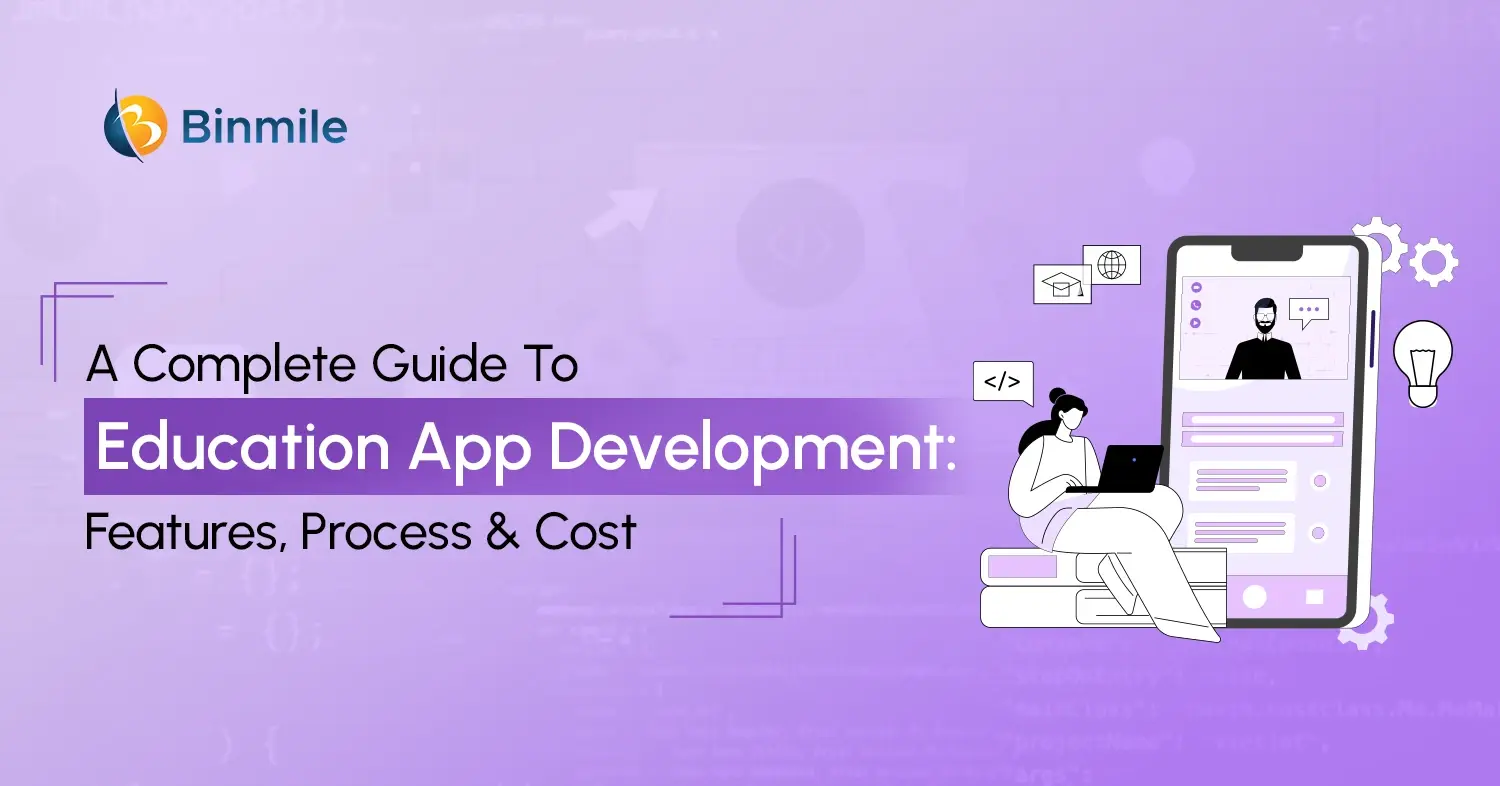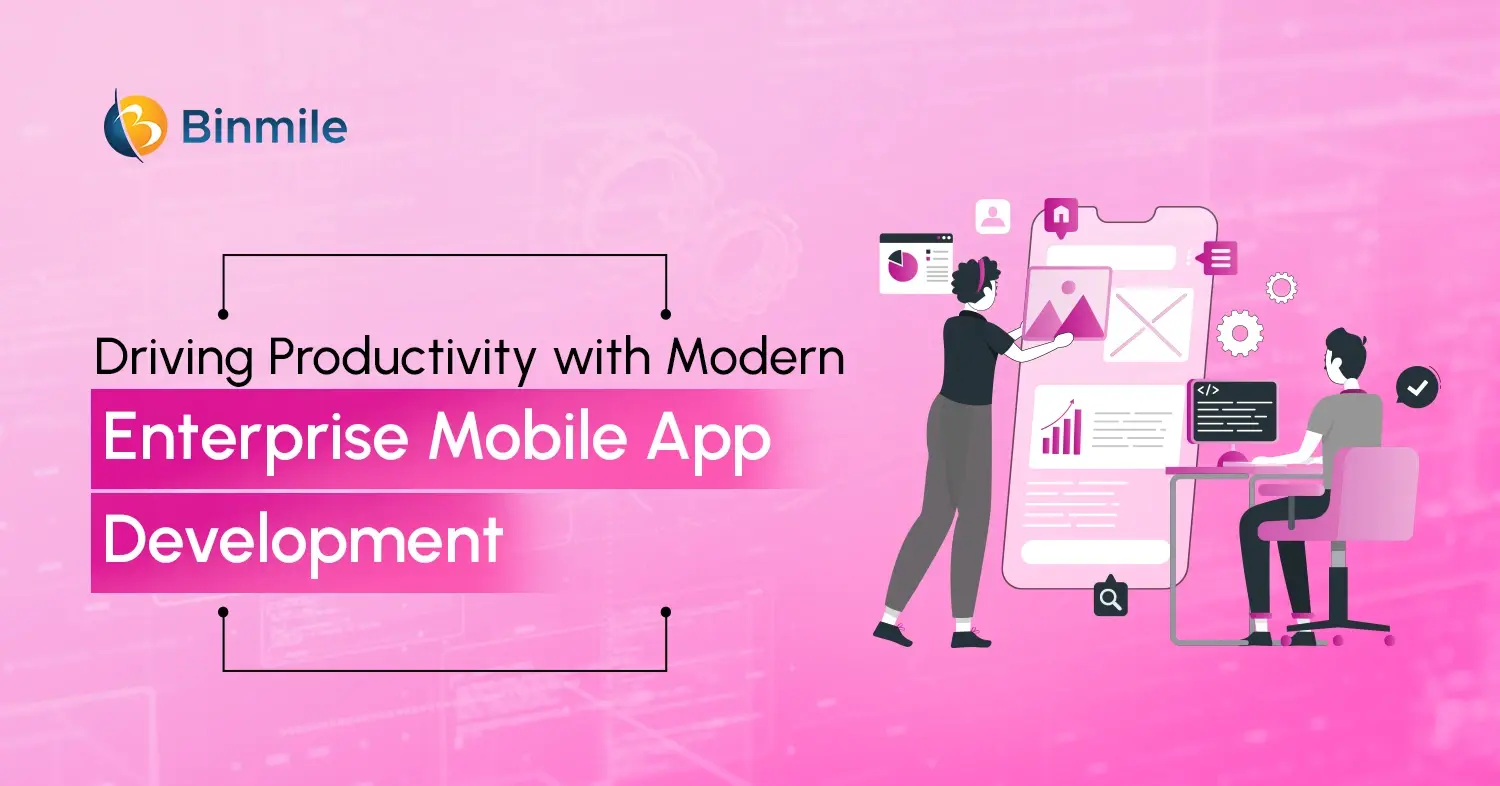The rise of super app development has reshaped the way we engage with digital services. This surge in popularity initially took root in Asia, where platforms such as WeChat and Alipay pioneered the way by extending their offerings beyond mere messaging and payments. These apps seamlessly integrate an array of services, ranging from flight bookings, and food delivery, to even banking services. As a result, they transformed into the ultimate destination for users, catering to their multifaceted needs.
The user-centric convenience of super apps along with its popularity has led businesses to tap into this market. However, the app development process of a successful super app has many ups and downs. Developers must navigate issues related to scalability or user experience, and many more to build a super app that truly enhances users’ lives. So what are these pain points? How to resolve these issues?
Let us address these challenges in detail and discuss best practices to turn them into opportunities for growth and innovation. Additionally, this blog will also provide a brief overview of the app, its benefits to businesses, and its top features.
Top Challenges of Super App Development & How to Fix Them
What is a super app? The app functions as a virtual marketplace, providing a digital storefront for various online businesses and shops to showcase and sell their products and services. Since there are a lot of apps with different features that need to be integrated, you may face challenges while building a super app. So, let us address some of the pain points here and also how to resolve them:
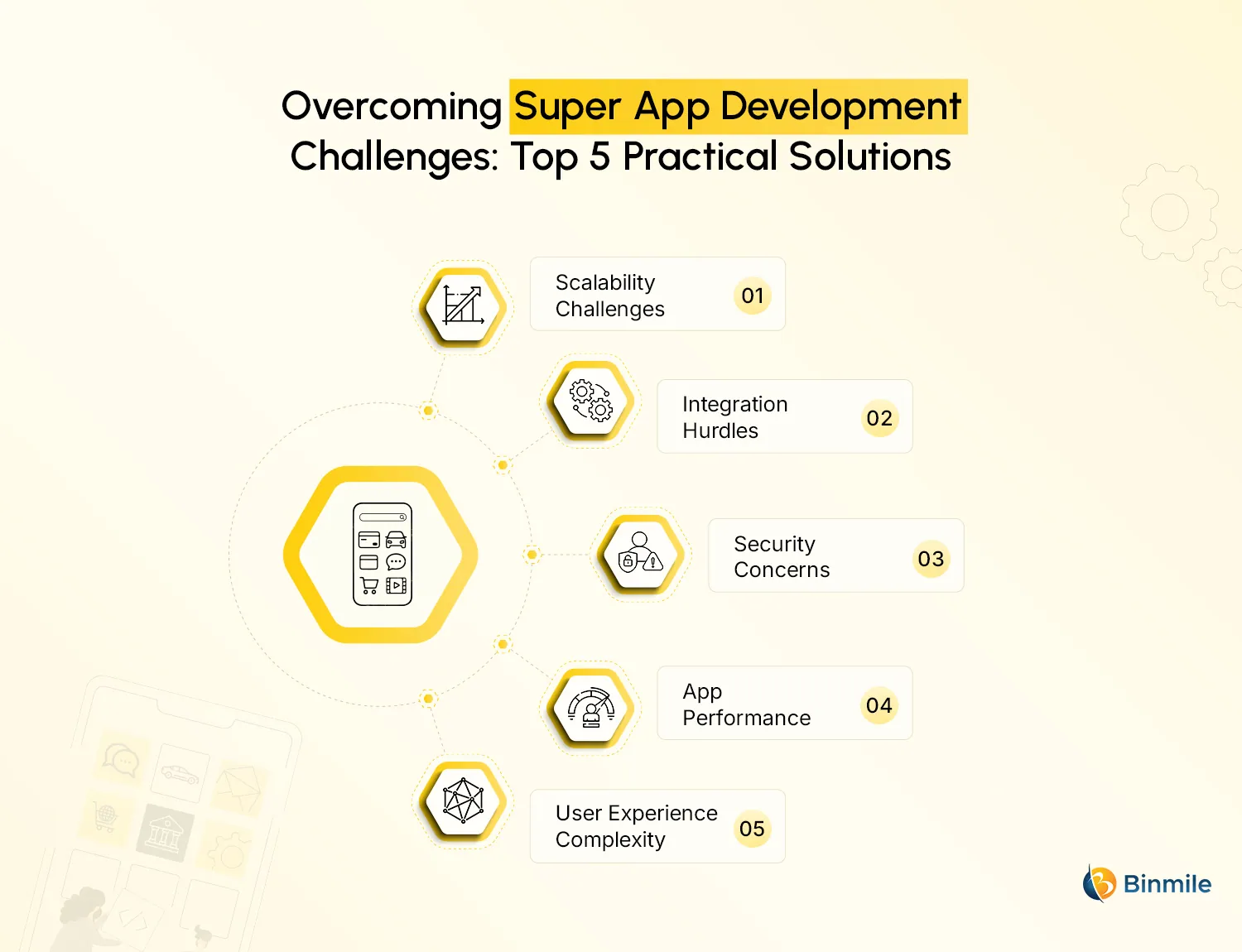
1. Scalability Challenges
Scalability is not just about handling more users; it’s also about adapting to changing market trends and user expectations. To ensure your product development of a super app can accommodate various services and users’ you require robust scalability. As the user base grows, the application must handle increased traffic and transactions efficiently. A lack of scalability can lead to frustrating downtime and a loss of users, which can be detrimental to the success of your super app.
Implementing a microservices architecture allows for modular scalability, where you can scale individual services independently. In addition, leverage cloud solutions for flexibility, enabling your app to allocate resources dynamically based on demand. Continuous monitoring and load testing also enable you to identify bottlenecks and optimize your app’s performance as it scales.
2. Integration Hurdles
Compatibility issues and data synchronization must be managed effectively while integrating various third-party services, such as payment gateways and ride-sharing APIs. Poorly executed integrations can lead to service disruptions and a frustrating user experience. Businesses need to work closely with service providers to establish clear communication and resolve compatibility issues promptly.
Using standardized APIs and protocols to simplify integration processes can help. In addition, implement robust data validation techniques to ensure that data transferred between services is accurate and consistent. Regularly test integrations to catch and address issues before they impact users.
3. Security Concerns
Protecting user data and transactions from potential threats is a critical challenge. Super apps must have robust security measures such as encryption of sensitive data to secure authentication methods. Cyber thefts or security breaches not only harm your users but can also lead to significant legal and reputational consequences.
Regularly conduct thorough security audits and penetration testing to identify vulnerabilities and address them promptly. Educate your development team about security best practices to ensure a security-conscious culture. Stay updated on cybersecurity best practices and proactively adapt your security measures to evolving threats.
4. App Performance
Super apps can become resource-intensive, impacting device performance and battery life. Balancing functionality with resource optimization is crucial. Slow or resource-hungry apps can frustrate users and lead to uninstallations. The code should be optimized for inefficient algorithms, and memory leaks with zero eliminating bottlenecks.
Employ caching strategies to reduce the need for repeated data requests. Offer settings for users to customize resource usage, allowing them to strike a balance between functionality and device performance. Regularly monitor your app’s performance and address any issues that arise promptly to ensure a smooth user experience.
5. User Experience Complexity
Super apps offer numerous features, which can make maintaining a seamless user experience challenging. Users expect smooth transitions between services and an intuitive interface. Ensuring a consistent and delightful user experience across all integrated services is crucial for user retention. Prioritize user-centric design by conducting in-depth user research to understand their behavior and preferences.
Develop a unified design language that’s consistent across all app sections. Conduct usability testing with real users to identify pain points in their journey through the app and make iterative improvements. To ensure the app remains intuitive and user-friendly, continuously gather user feedback to refine the app’s interface.
5 Business Benefits of Super App Development
There is no doubt that super apps offer comprehensive mobile application services such as messaging, e-commerce, payments, ride-sharing, and more within a single interface. This enhances a user’s interaction with the app and boosts engagement rate. It also provides benefits to businesses, so let us focus on them:
Super Apps offer several compelling benefits for businesses:
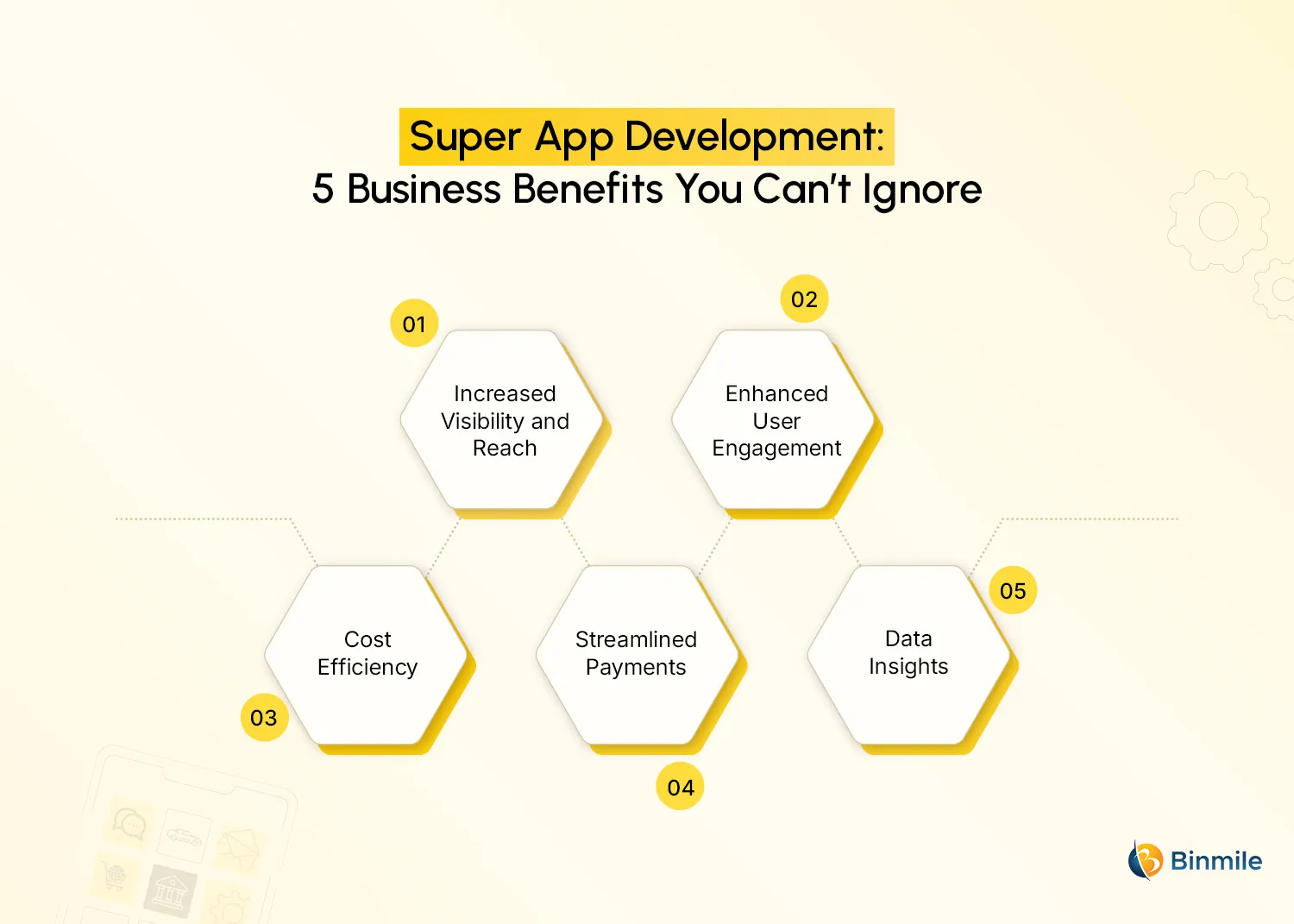
- Increased Visibility and Reach: Being part of a Super App ecosystem exposes businesses to a vast user base, increasing their visibility and potential customer reach exponentially.
- Enhanced User Engagement: Super Apps often provide businesses with tools for personalized marketing and communication, allowing them to engage with users more effectively and tailor their offerings based on user behavior and preferences.
- Cost Efficiency: Businesses can save on mobile app development costs by integrating their services into an existing super app rather than building and promoting a standalone app, making it a cost-effective strategy.
- Streamlined Payments: Super apps typically offer integrated payment solutions, simplifying transactions for businesses and users alike while reducing friction in the buying process.
- Data Insights: Access to the super app’s user data and analytics can empower businesses with valuable insights into customer behavior, enabling them to make data-driven decisions and refine their strategies for better results.
Take your business to the next level with custom super app development. Get in touch today to build your unified app experience!
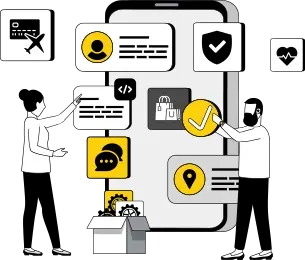
Successful Super App Development Guide: Step-by-Step Process
Certain features can help you offer users access to multiple functions seamlessly in one app thus making their lives more convenient.
- A super app seamlessly integrates various services, offering users a comprehensive platform for diverse needs.
- It must offer personalized recommendations to enhance user satisfaction and engagement within the app.
- A unified digital wallet simplifies secure transactions across multiple services.
- In-app messaging and social features facilitate effortless communication and networking.
Third-party integration expands the app’s ecosystem, providing a wider range of functionalities.
Now, let’s delve into the top tips to deliver supper app development services.
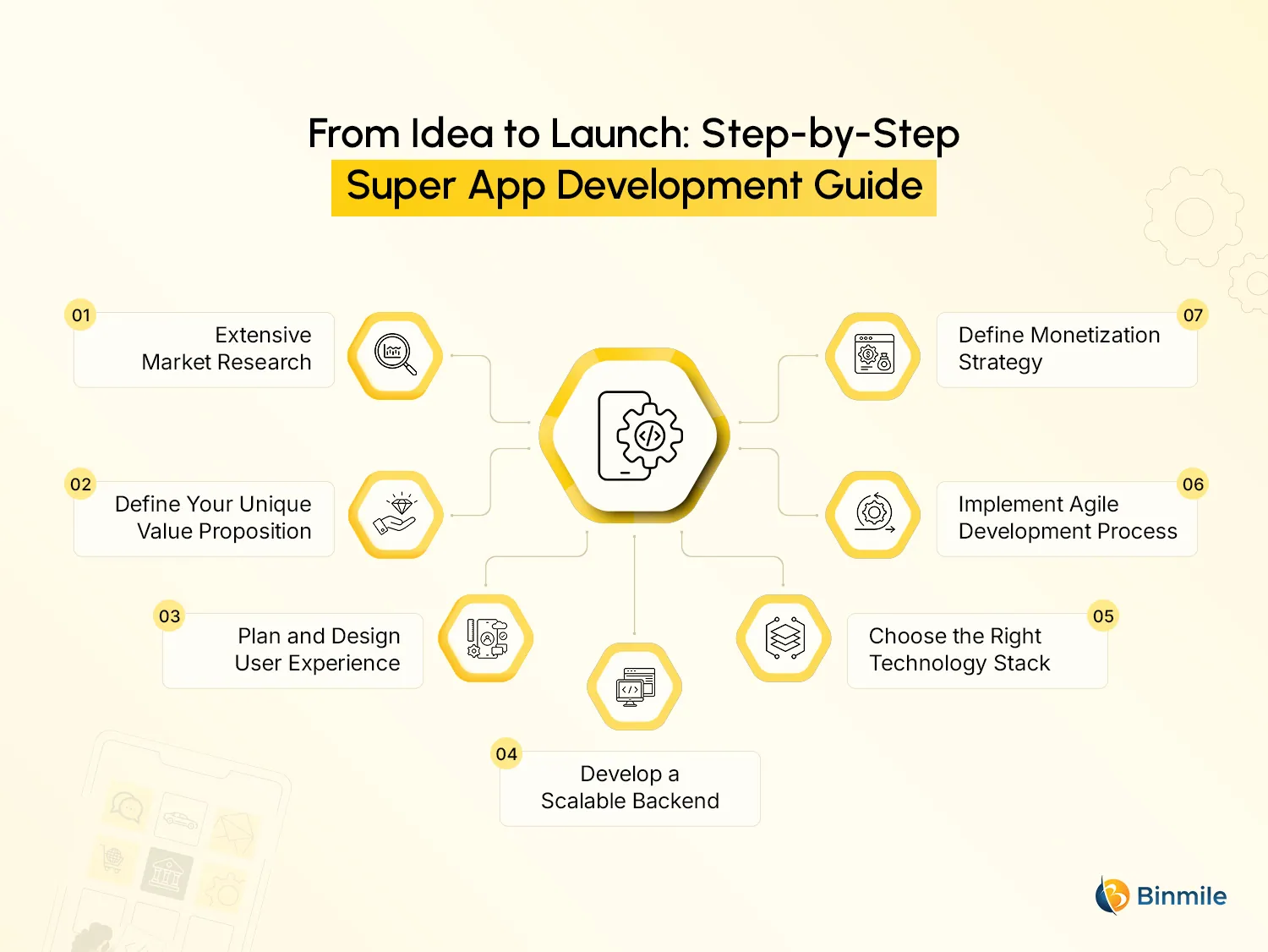
1: Extensive Market Research
Conduct comprehensive market research with solid attention to detail. Thoroughly grasp your target audience’s characteristics, requirements, preferences, and behavioral patterns. Identify voids within the market that your super app can proficiently address.
2: Define Your Unique Value Proposition
Start by precisely setting the distinguishing aspects of your super app. Establish a value proposition that answers the fundamental question: “Why should users choose your app?” This proposition must explain a unique offering or superior solution.
3: Plan and Design User Experience
Prioritize the development of an impeccable user-centered experience for an enhanced user experience. Begin with meticulous wireframing and prototyping to envision the app’s layout and functionalities. Ensure that the design aligns seamlessly with your value proposition and the outcomes of your user research.
4: Develop a Scalable Backend
Establish a robust and scalable backend infrastructure. This infrastructure should exhibit the capacity to handle increased user traffic and possess the ability to expand in tandem with your growing user base. Also, keep compliance, security, and data privacy at the forefront.
5: Choose the Right Technology Stack
Be specific about selecting an appropriate technology stack for an enriching experience for your users. Consider key factors such as scalability, security, and cross-platform compatibility (iOS, Android, web). In addition, the chosen technology stack must align cohesively with your app’s long-term growth and stability.
6: Implement Agile Development Process
Embrace an agile development methodology, characterized by iterative cycles. Commence with the introduction of a minimum viable product (MVP) to gather invaluable user feedback. Subsequently, meticulously refine and enhance your app based on the feedback received. This iterative approach facilitates adaptation to dynamic user needs and market dynamics.
7: Define Monetization Strategy
Decide upon your app’s monetization strategy with precision. Contemplate models such as subscription services, in-app advertising, freemium options, or a strategic amalgamation of these approaches. Ensure that your monetization strategy resonates harmoniously with your target audience and aligns coherently with the value your app delivers.
Ready to conquer super app development hurdles? Your roadmap to super app success starts with our app development solutions to Boost visibility, engagement, and revenue.
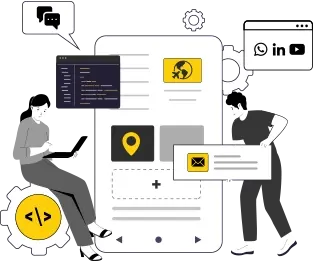
How Much Does It Cost to Develop a Super App?
Building a super app depends a lot on what kind of features, security measures, or UI/UX you want to install in your app. Still, product development of an MVP can be somewhere between $30,000 and $60,000. And if you want to include custom and advanced features it can cost nearly $60,000 to $250,000.
To make the development process simpler, cost-effective, and seamless, you can work with a top mobile development company that not only can provide you with a detailed and exact cost but can go beyond the budget. It can assist you in building the highest quality custom app within the set timeline and based on your specific requirements.
Factors Influencing Super App Development Cost
Here are 5 major reasons that can impact your super app development cost:
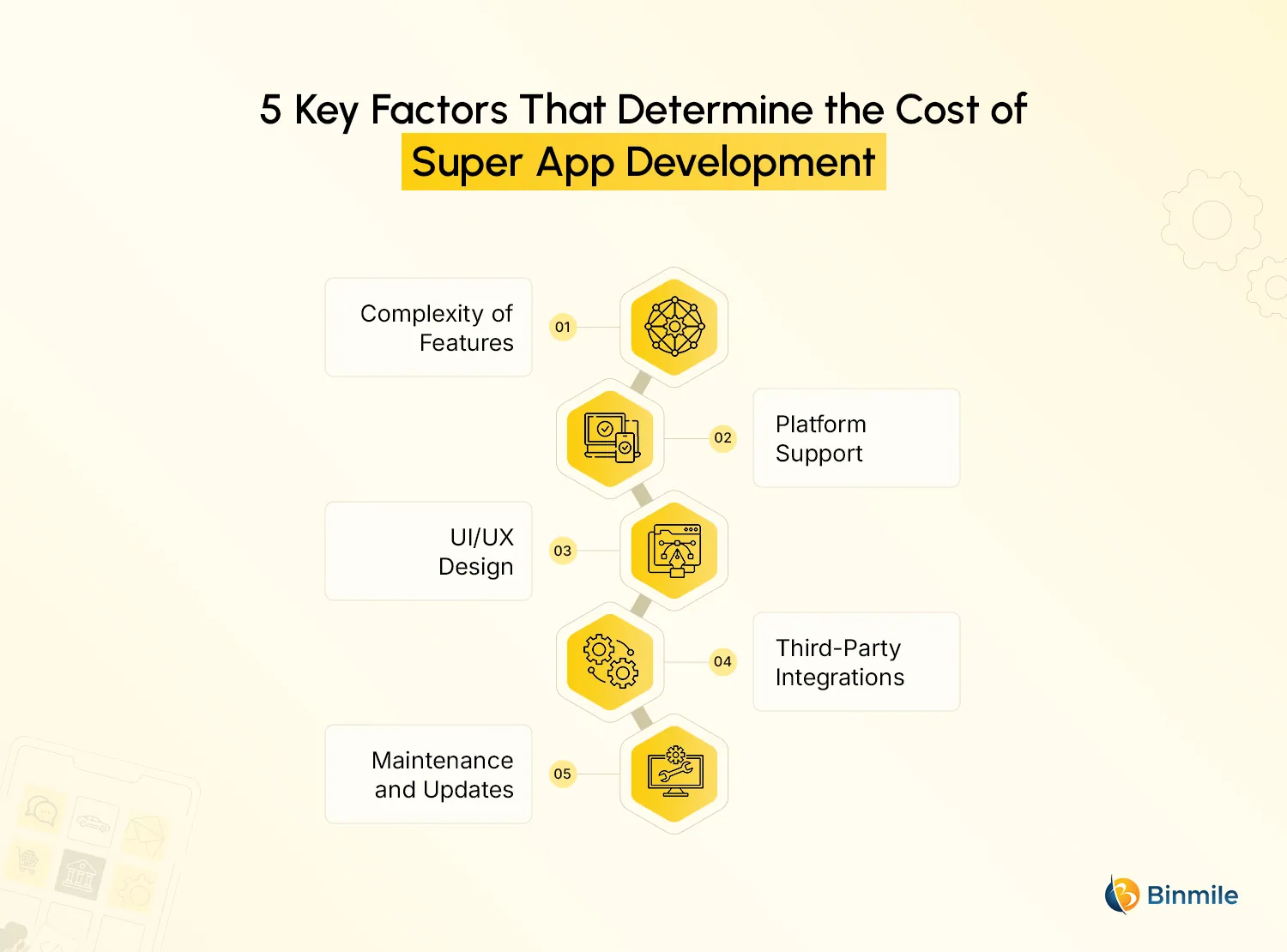
- Complexity of Features: The super app development depends a lot on what kind of functionalities you’d prefer in your super app. Naturally, the more intricate each feature is, the more development time and resources it requires.
Range: $10,000 to $100,000+ per complex feature, depending on its nature. - Platform Support: Cross-platform compatibility is what helps you reach a wider audience, which means making your app available on both Android and iOS. Since developing for two platforms leads to higher development costs.
Range: $15,000 to $30,000 per platform is a starting point. - UI/UX Design: Developing a user-friendly and intuitive interface is what makes your app easily acceptable. So, consider factors such as several design iterations, the use of custom animations, and the overall complexity of the UI that influences the cost.
Range: $10,000 to $50,000+ for highly-designed Super App UI/UX - Third-Party Integrations: Integrating functionalities such as payment gateways or social media logins leads to additional fees and development time. So, just like the code complexity of features, the more third-party integrations you go for, the higher the super app development cost will be.
Range: $5,000 to $20,000, or more depending on the number or type of third-party integrations. - Maintenance and Updates: Super Apps are constantly evolving, naturally your app needs to keep up with the changes. Factor in, ongoing bug fixes, security updates, and new feature additions require a decent amount of resources in terms of dedicated team and money.
Range: 10-20% of the initial development cost for yearly maintenance.
To make the app development process simpler, cost-effective, and seamless, you can work with top app development companies that not only can provide you with a detailed and exact cost but can go beyond budgeting. It can assist you in building the highest quality custom app within the set timeline and based on your specific requirements.
Wrapping Up
Super app development has emerged as a powerful force both for businesses and users. For businesses it serves as an integrated e-commerce platform, allowing them to offer products or services directly within the app. For users, the app has simplified their buying journey by consolidating different services under one virtual roof. However, the process of building these super apps is not without its share of obstacles. The challenges of scalability, user experience modernization, integration, security, and performance may seem daunting, but they are not impossible to resolve.
With the right approach and a dedication to excellence, developers can pave the way for the future of mobile services, ensuring that super apps continue to evolve and flourish, meeting the diverse needs of users around the globe. In this blog, we explored the pain points of super app development and shared some proactive steps to resolve them. By understanding these pain points and implementing the suggested solutions, developers can transform these challenges into stepping stones toward creating super apps that redefine convenience and elevate the digital experience.
Frequently Asked Questions
A super app strategy refers to the approach taken by companies to develop a comprehensive digital platform that offers a wide range of services and functionalities within a single integrated ecosystem. These super apps serve as a one-stop solution for users’ daily needs, including shopping, payments, transportation, food delivery, entertainment, and more.
Top super apps generate revenue through various monetization strategies, including:
- Transaction fees: Charging users or merchants transaction fees for payments, deliveries, bookings, or other services facilitated through the platform.
- Advertising: Displaying targeted advertisements or sponsored content within the app to generate advertising revenue from advertisers and partners.
- Subscription services: Offering premium or subscription-based services, features, or content to users in exchange for a recurring fee or subscription revenue.
- Commission or service fees: Earning commissions or service fees from third-party vendors, merchants, or service providers for transactions or sales made through the platform.
- Licensing and partnerships: Generating revenue through licensing agreements, partnerships, or white-label solutions with other companies, brands, or organizations.
A super app is a comprehensive digital platform that offers a wide range of services and functionalities within a single integrated ecosystem. Unlike traditional standalone mobile applications, super apps aim to provide users with a seamless and centralized experience for various daily needs, including communication, shopping, payments, transportation, food delivery, entertainment, and more.
Super apps integrate multiple services and features into a single platform, allowing users to access diverse functionalities through a unified interface or application. Users can perform tasks such as messaging, shopping, ordering food, booking services, making payments, and managing finances without needing to switch between different apps or platforms. Super apps often leverage technologies such as artificial intelligence, machine learning, and data analytics to personalize user experiences and optimize service delivery.


